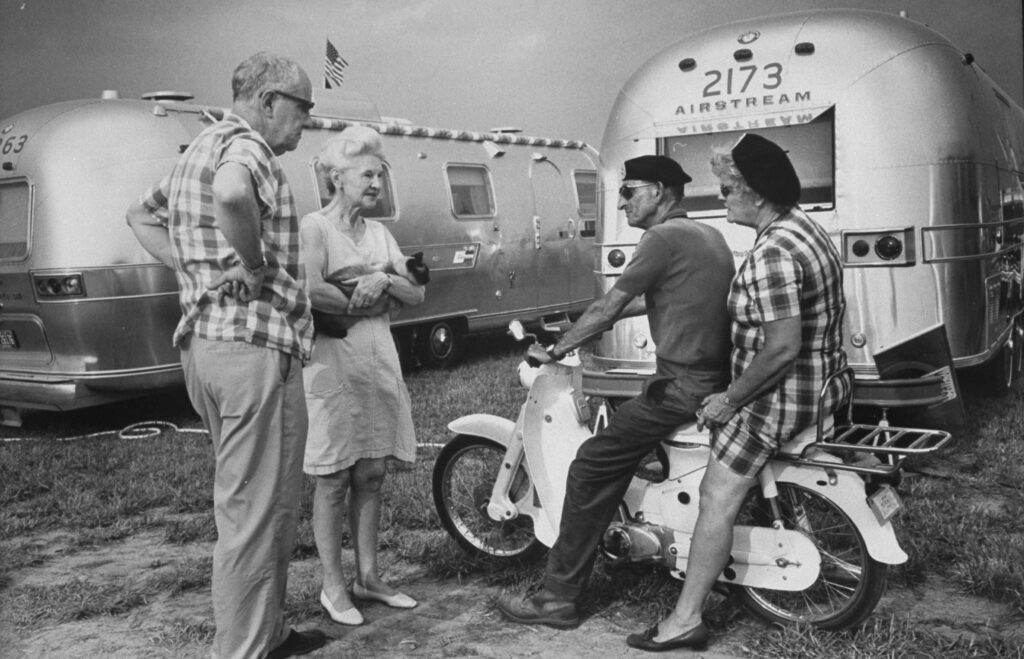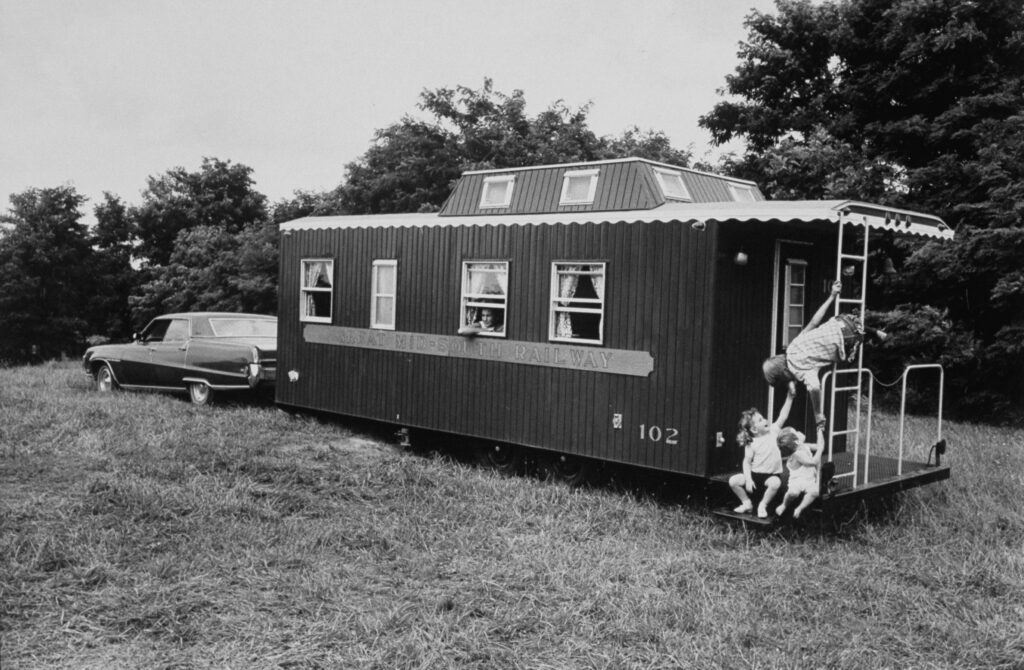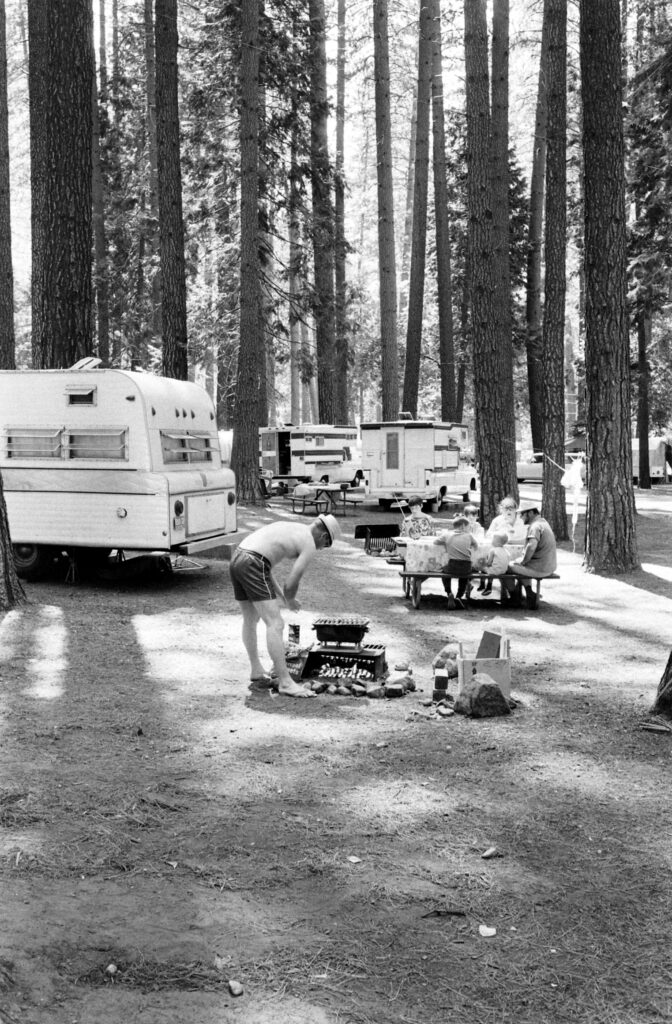The cover story of the Aug. 14, 1970 issue of LIFE magazine highlighted the “Summer Nomads” who hit the road in the latest and greatest recreational vehicles.
The phenomenon was burgeoning then, but it was not new. The history of the RV dates back to 1915, when the Conklin family retrofitted a bus by installing four beds and traveled the country in it. That started a craze which has continued and recently took new form with the #vanlife craze that flourished during the COVID-19 pandemic.
LIFE’s story, titled “Home, Home on the Road,” talked about how travelers in 1970 were flooding America’s national parks, and one big reason for this was the success of the recreational vehicle.
Part of the crush [at national parks] comes from the recent popularity of house trailers, truck-mounted “campers” and van-like motor homes, which can simply be wheeled into place at a campsite. There are more than 2.5 million of these, some of them elegantly furnished, with double beds, television and air conditioning, and many owners freely admit they aren’t nearly so interested in the great outdoors as they are in camaraderie of their fellow wheeled nomads.
The photos by Ralph Crane captured the great variety of mobile homes of that era. The star of the story was the Airstream, a trailer with a distinctive rounded aluminum body that had been around since 1936. Crane chronicled an annual gathering of Airstream devotees in Hershey, Pa., and also group of Airstream users who met in Great Falls, Mont., in advance of taking a group trek through Canada and up to Alaska. The Airstream remains popular today as do the gatherings: the big 2023 rally is slated for Rock Springs, Wyoming.
The story also surveyed other recreational vehicles, noting that what LIFE called “self-contained motor homes” such as the Winnebago were the fastest growing sector of the market.
And the essay included a tricked out van that is a forebear of the sort of vehicles that gained in popularity during the COVID pandemic age as #vanlife become a hot hashtag and more people pursued the dream of living a nomadic life.
Look through these pictures by Ralph Crane, and you’ll see people who used trailers find not just mobility but also community at the same time that they were getting away from it all.

Airstream trailers converged on a campground for a rally in Hershey, Pa., 1970.
Ralph Crane/Life Picture Collection/Shutterstock

Scene from a gathering of Airstream uses in Hershey, Pa., 1970.
Ralph Crane/Life Picture Collection/Shutterstock

George Grening and his wife (right) at an Airstream trailer rally, 1970; they brought their motorcycle along for quick side excursions.
Ralph Crane/Life Picture Collection/Shutterstock

Bob Newcomb and his family posed in front of their trailer at an Airstream convention in Hershey, Pa., 1970.
Ralph Crane/Life Picture Collection/Shutterstock

Bob Newcomb with a 16-month-old in his trailer, 1970.
Ralph Crane/Life Picture Collection/Shutterstock

Attendees at a trailer rally, 1970.
Ralph Crane/Life Picture Collection/Shutterstock

Scene from an Airstream trailer rally, 1970.
Ralph Crane/Life Picture Collection/Shutterstock

About 10,000 trailer fans converged on Hershey, Pa. for an annual gathering, 1970.
Ralph Crane/Life Picture Collection/Shutterstock

Aerial view of an annual gathering of Airstream travelers in Hershey, Pa., 1970.
Ralph Crane/Life Picture Collection/Shutterstock

Attendees at a trailer rally, 1970.
Ralph Crane/Life Picture Collection/Shutterstock

A group of Airstream travelers gathered in Great Falls, Montana before heading out on a trek across Canada and Alaska, 1970.
Ralph Crane/Life Picture Collection/Shutterstock

This model of trailer was 25 feet long and capable of sleeping up to 11 people, depending on the layout plan. Its cost in 1970 was $5,400.
Ralph Crane/Life Picture Collection/Shutterstock

From a 1970 LIFE story on the burgeoning popularity of trailer travel.
Ralph Crane/Life Picture Collection/Shutterstock

This wheeled bed by Wheel Mate was designed to be towed by motorcycle or small car. It came with a mattress and folding frame top and cost $480 in 1970.
Ralph Crane/Life Picture Collection/Shutterstock

The tent trailer, described by LIFE in 1970 as a common starter mobile home, cost between $300 and $2,000. The tent collapsed into the trailer for towing, and one model included a pullout kitchen.
Ralph Crane/Life Picture Collection/Shutterstock

This Gypsy Mini-Home was a 1970 example of a converted van; they sold for between $3,000 and $7,000 and included beds for up to five people.
Ralph Crane/Life Picture Collection/Shutterstock

This amphibious unit could slip off its trailer and become a houseboat; it featured wall-to-wall carpeting and cost $10,800 in 1970.
Ralph Crane/Life Picture Collection/Shutterstock

Self-contained motor homes like this one were in 1970 the fastest-growing category of recreational vehicle; this couple played cards in a 36-foot Winnebago that cost $8,500.
Ralph Crane/Life Picture Collection/Shutterstock

From a 1970 story on the burgeoning popularity of trailer life.
Ralph Crane/Life Picture Collection/Shutterstock

From a 1970 story on the burgeoning popularity of trailer life.
Ralph Crane/Life Picture Collection/Shutterstock




























